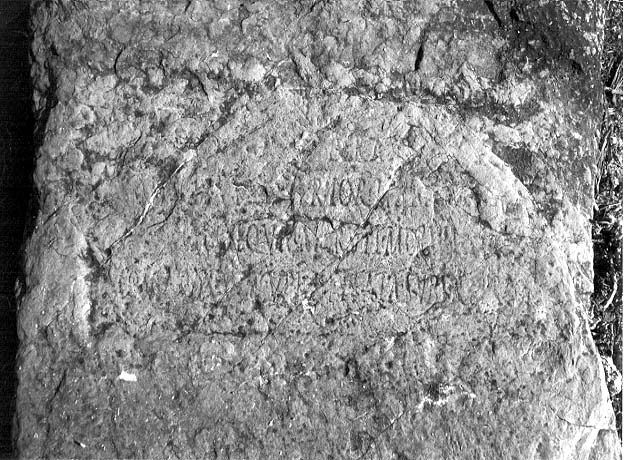Funerary stele
Reference CIL II2 / 5,1124 | Description | Lyrics | Location | Chronology | Epigraphic edition | Translation | Apparatus | Comentary | Type of verse | Text divided into verses and metric signs | Images | Bibliography | Link to DB | Author |
Funerary stele
Description
- Idno filename 22/01/0052
- Type of inscription: Sepulcralis
- Material Description: Stele in brown limestone (‘jabaluna’).
- Dimensions height/width/depth (cm): 166/60/35
-
Epigraphic field:
- Layout: Upper part semicircular, rare in the area, according to Antonio Fernández Ugalde, archeologist director of the Museo de Écija. Framed within the stele is a console, possibly topped with an ornamental semicircle. Here the carmen is engraved, making for two different epigraphic fields: one possibly not marked off or surrounded by a moulding, which would contain the prose praescriptum, and the console with the carmen. Triangular interpunction with the vertex pointing downwards, appearing to separate all words.
- Epigraphic field state of conservation: Stone in very poor condition, with a badly eroded and damaged surface, so that it is very difficult to read the epigraph – even impossible in some parts.
- Epigraphic field dimensions hieght/weight (cm): 42/23
- Preserved
Lyrics
- Font:Libraria
- Letter size:Letter height: 4.5 in the first line and 2.5 in the rest. cm
- Description of the letters:Book script; larger outside the frame, smaller and compressed inside.
Location
- Place of discovery: According to the first editors, the stone was found in 1995, in the Cortijo Molino de la Torre and was apparently from the area of the necropolis of the nearby Cortijo del Villar, in the municipality of Écija (Astigi), Sevilla.
- Geolocation
- Conservation location: Currently on the outer boundary of that same property, which is now derelict, on the road from Écija to La Lantejuela, some 13 km outside Écija.
- Location with Modern Nomenclature España / Sevilla / Cortijo del Villar
- Location with Old Nomenclature Hispania / Baetica / Astigitanus / Astigi
Chronology
- Inscription's dating: Between year 101 and year 199
- Dating explanation: Stylow and Ordóñez Sáez date it to around the 2nd c. from the form of the letters.
Type of verse
- Type of verse: Dactílico (ritmo)
- Verse/line correspondence: No
- Prose/verse distinction: Si
Epigraphic edition
‑ ‑ ‑ ‑ ‑ ‑
[‑ ‑ ‑]++ia [‑ ‑ ‑]
(vac.)
[‑ ‑ ‑]lerat ▴ [‑ ‑ ‑]
5 [‑ ‑ ‑]arior ▴ ipsa [‑ ‑ ‑]
[‑ ‑ ‑]++e qu+ meruit ▴morum[‑ ‑ ‑]
CO+++B++ ▴ V+IER ▴ nata ▴ sub+[‑ ‑ ‑]
Text divided into verses and metric signs
– – – – – –
[‑ ‑ ‑]lerat [‑ ‑ ‑] [ln|lk]k|x/[n|ln|lkk|l~]?
[‑ ‑ ‑ c]arior ipsa [‑ ‑ ‑] [ln]|lkk|lk/[k|ln|lkk|l~]
[‑ ‑ ‑]e qu[-] meruit morum [‑ ‑ ‑] [l]x|[l]/kk|l/l|x/[n|lkk|~]
5 [- – -] nata sub+[‑ ‑ ‑] [ln|ln]|lk/x|[ln|lkk|l~]
– – – – – –
Translation
The text is too fragmentary to enable us to propose a reasonable translation.
Bibliography
Ordóñez Agulla – Sáez 1996, 104–106, n. 4; Stylow, II2/5, 1124 (HEp 1997, 838b); Fernández Martínez – Carande, CLEB SE18; Cugusi 2012, 50.
Apparatus
D(is) M(anibus) [s(acrum)] Stylow, quod non legimus nec Ordóñez Agulla – Sáez. –1 [Co]rnelia Stylow; [ ].R… Ordóñez Agulla – Sáez. – [ ]+ian[a] Stylow ut v. 3 quod non legimus nec Ordóñez Agulla – Sáez. – 3 [ 8 10 c?]arior libri[s] Stylow; ]ERTORI…SA Ordóñez Agulla – Sáez. – 4 [ 6? ]IEQV[ 5? ]uit morum Stylow; [ ]..IQV….R..TIMORV Ordóñez Agulla – Sáez. – 5 CO+[ 8? ] supe[r]+++ATA subi[t?] Stylow; [ ]CO…..V…NATA SVBI Ordóñez Agulla – Sáez.
Comentary
Funerary stele with a surface in very poor condition, so much so that most of the inscription is illegible. We could not make out a single letter of the dedication to the Manes which Stylow edited; the first elements we are able to read, about 15 cm from the upper edge, are the vertical remains of two letters, an <I> and an <A>, so that the name of the deceased could in fact be Cornelia, in accordance with Stylow‘s reconstruction. After this line there is a blank space of about 32 cm, where we could not see the remains of any letters at all, while Stylow read remains of letters in what he edited as a third line. Enclosed in a console which may have been semicircular at the top, among cracks, scratches and eroded areas, fragments can be read of what must have been a dactylic carmen, dedicated to the deceased. Little can be interpreted from the content, as no complete words are preserved here.
In l. 2 we read []lerat, followed by an interpunction sign, which allows us to think in verbal forms such as tulerat, intulerat, contulerat, abstulerat, all of them with parallels in epigraphic poetry and compatible with dactylic rhythm. All the examples contain references to destiny, to the land, to the gods, etc., for having “taken” the deceased (cf., for example, CLE 382,2, 1309,3). In l. 3 we read [c]arior ipsa, compatible equally with the dactylic rhythm and which could praise the family affection (between parents and their children, especially, as it is usual in this type of compositions), as it happens in CLE 1220,3: dulcis eram matri, carior usque patri. In l. 4 ruit could mean mors immatura with four epigraphic parallels in singular (1310,6; 1786,3; 1069,2; 1424,2) and some also in plural. With the next word, morum, the qualities of the deceased could be exalted, as it happens in 511,1: columen morum ac pietatis or in 1430,5: casta, decus morum, sapiens, devota marito / ornabas. The only thing that the only complete word that we read in l. 5 could confirm us, nata, is that we are before a case of mors immatura. From the metric sequences that can be isolated, it must have been a dactylic carmen.
Author
- Author:C. Fernández Martínez, R. Carande Herrero
- Last Update2024-02-25 19:56:16
- Autopsy date:2004
You can download this





